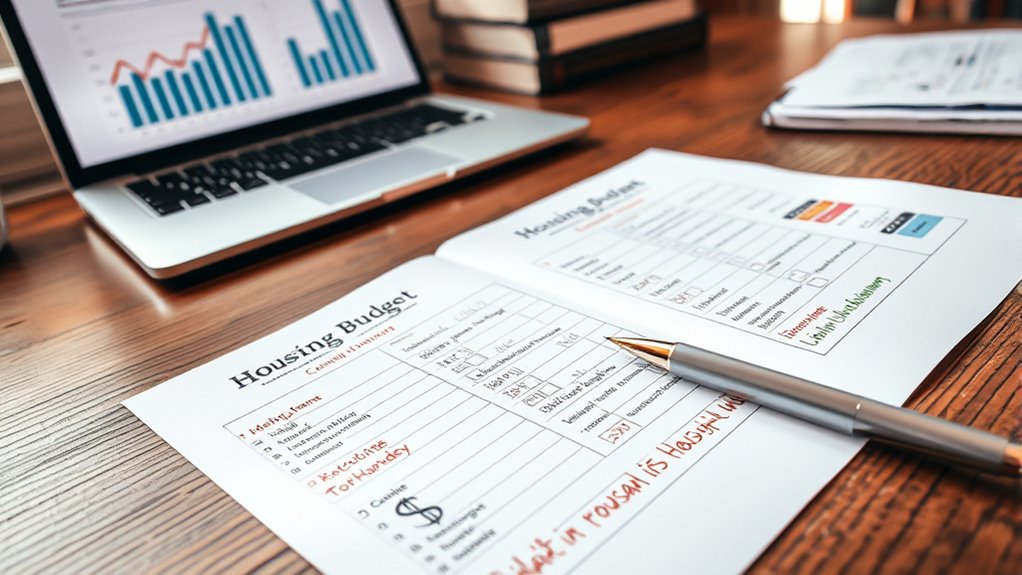A housing budget worksheet for post-divorce moves helps you organize and track your housing expenses, making it easier to evaluate rental or mortgage options. It allows you to compare costs side by side, including utilities and maintenance, so you don’t overextend your finances. By adjusting for your current income and expenses, you can set realistic housing goals suited to your new situation. Keep exploring to learn how this tool can support your financial stability and homeownership plans.
Key Takeaways
- Organizes housing expenses to ensure affordability during post-divorce transitions.
- Compares rental options, including utilities and maintenance, for informed decision-making.
- Calculates mortgage scenarios to determine sustainable homeownership options.
- Adjusts housing plans based on changes in income and financial circumstances.
- Supports setting realistic housing goals aligned with current financial capacity.

A housing budget worksheet is an essential tool that helps you organize and track your housing expenses. When you’re steering a post-divorce move, understanding your financial limits becomes even more critical. This worksheet enables you to assess rental affordability, ensuring you don’t stretch your budget too thin or compromise your financial stability. By accurately listing your income and expenses, you can determine what rent or mortgage payments fit comfortably within your financial picture. It’s easy to overlook hidden costs or underestimate expenses without a clear plan, but a detailed worksheet keeps everything transparent and manageable.
A housing budget worksheet helps you organize expenses and assess affordability during a post-divorce move.
When considering rental options, the worksheet helps you evaluate whether a particular property aligns with your income and expenses. You can compare different rental prices side by side, factoring in utilities, maintenance, and other recurring costs. This way, you avoid the trap of overextending yourself financially just because a place seems appealing. It also guides you in setting realistic expectations about what you can afford, helping you avoid the stress of unmanageable payments down the line. If you’re leaning toward buying property, the worksheet becomes instrumental in mortgage planning. It allows you to calculate potential mortgage payments based on interest rates, loan terms, and down payments. This way, you can see how different mortgage scenarios impact your monthly budget, making informed decisions about what you can afford and what might be too risky.
The primary value of a housing budget worksheet lies in its ability to give you a clear picture of your financial capacity. Post-divorce, your income may have changed, and your expenses might have increased due to new living arrangements or legal obligations. The worksheet helps you adjust your housing plans accordingly, avoiding surprises or financial stress. When you comprehend your rental affordability and mortgage options, you can focus on finding a home that fits your lifestyle and budget without compromising your financial goals. It’s a proactive approach that empowers you to make confident decisions, whether you’re renting or buying.
Additionally, understanding your financial health can guide you in setting realistic housing goals and prevent future financial strain. Ultimately, a well-structured housing budget worksheet ensures that your move supports both your immediate needs and long-term financial health. It’s a practical, straightforward tool that keeps your housing choices aligned with your income and expenses, giving you peace of mind during what can be a hectic transition. By taking the time to thoroughly analyze your finances with this worksheet, you set yourself up for a stable, affordable housing situation that supports your new chapter post-divorce.
Frequently Asked Questions
How Often Should I Update My Housing Budget Worksheet?
You should update your housing budget worksheet at least once every three to six months. This allows you to account for rent adjustments, utility planning, and any changes in your income or expenses. Regular updates help you stay on top of your financial situation, especially after a divorce, ensuring your budget remains accurate and manageable. Keep an eye on rent increases and utility costs to adjust your plan proactively.
Can I Include Future Housing Costs in My Current Budget?
Yes, you can include future housing costs in your current budget, especially if you anticipate rent increases or need to pay a new security deposit. Planning ahead helps you stay prepared for changes, like a rent increase, and covers upfront expenses. Make sure to update your worksheet once you have concrete figures, so your budget remains accurate and reflects your upcoming financial obligations.
How Do I Account for Unexpected Moving Expenses?
You should set aside funds for unexpected moving expenses by building an emergency fund specifically for this purpose. Use accurate cost estimation to determine potential costs, like moving services or repairs. Keep a separate savings account for these emergencies, and regularly contribute to it. This way, when surprises happen, you won’t jeopardize your overall budget, ensuring you’re prepared for any unforeseen costs during your move.
What if My Income Varies Month to Month?
If your income varies month to month, you should track your variable income and fluctuating expenses closely. Create a flexible budget that accounts for your lowest earning months, ensuring you can cover essential costs. Set aside a buffer or emergency fund during higher-income months to cover leaner periods. This approach helps you manage financial stability despite income fluctuations, giving you peace of mind during your post-divorce move.
Should I Seek Professional Financial Advice for My Housing Budget?
Yes, seeking professional financial advice can be very helpful for your housing budget, especially when you’re dividing expenses after a divorce. A financial advisor can assist with your financial planning, helping you create a realistic budget that adapts to your fluctuating income. They can also guide you on managing expenses effectively, ensuring you’re prepared for future costs and making informed decisions about your housing situation.
Conclusion
Now that you have this housing budget worksheet, you’re better equipped to plan your post-divorce move confidently. Remember, understanding your finances helps you make smarter choices and reduces stress during this progression. Are you ready to take control of your housing future and find a space that truly fits your new chapter? With a clear plan in hand, you can move forward with confidence and peace of mind.










